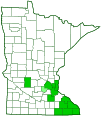prairie shooting star
(Primula meadia)
Conservation • Wetland • Description • Habitat • Ecology • Use • Distribution • Taxonomy
Description |
||
Prairie shooting star is a 8″ to 24″ tall, erect, perennial forb that rises from fibrous, slightly thickened roots. The roots produce a rosette of basal leaves and one or more flowering stalks. There is no central stem. The leaves are all basal. They are oblong or oblong lance-shaped, 2⅓″ to 8″ long, but usually no longer than 4″, and ¾″ to 2½″ wide. They are rounded or blunt at the tip, taper gradually to the leaf stalk, and are reddish at the base and along the single, conspicuous midvein. The margins are untoothed. The upper and lower surfaces are hairless. The inflorescence is an umbel of 4 to 25 flowers at the end of a leafless, hairless, flowering stalk (scape). The flowers are ⅜″ to 1″ long and hang downward at the end of 1½″ long, arching flower stalks. The corolla is white, light pink, or rosy pink, rarely magenta, with a yellow band and maroon spots near the base. Most populations in the northern part of the species’ range have white flowers. Most populations in the north have flowers tinged with pink, rosy pink, or magenta. The petals are bent back strongly near the base and are held mostly erect. There are 5 stamens with anthers fused into a cone-shaped tube. There is no floral scent. The fruit is an egg-shaped, dark reddish-brown capsule, ¼″ to ⅔″ long, less than 3 times as long as wide, with many seeds. The wall of the capsule is thick and firm. The capsule does not split at the bottom. |
||
Height |
||
8″ to 24″ |
||
Flower Color |
||
White, light pink, or rosy pink, rarely magenta |
||
Similar Species |
||
Jeweled shooting star (Primula fassettii) petals are mostly deep rose-purple or pink, rarely white. The wall of the capsule is thin and flexible. |
||
Habitat |
||
Dry to wet. Prairies, woods. Full sun. |
||
Ecology |
||
Flowering |
||
April to June |
||
Pests and Diseases |
||
|
||
Use |
||
|
||
Distribution |
||||
|
Sources The two sightings in Carver County (light green on the map) are both from the Minnesota Landscape Arboretum, where it is not “outside of cultivation.” |
|||
| 5/29/2023 | ||||
Nativity |
||||
Native |
||||
Occurrence |
||||
Rare in Minnesota |
||||
Taxonomy |
|||
| Kingdom | Plantae (green algae and land plants) | ||
| Subkingdom | Viridiplantae (green plants) | ||
| Infrakingdom | Streptophyta (land plants and green algae) | ||
| Superdivision | Embryophyta (land plants) | ||
| Division | Tracheophyta (vascular plants) | ||
| Subdivision | Spermatophytina (seed plants) | ||
| Class | Magnoliopsida (flowering plants) | ||
| Superorder | Asteranae | ||
Order |
Ericales (heathers, balsams, primroses, and allies) | ||
Family |
Primulaceae (primroses) | ||
| Subfamily | Primuloideae | ||
| Tribe | Primuleae | ||
Genus |
Primula (primroses) | ||
| Subgenus | Auriculastrum | ||
| Section | Dodecatheon (shooting stars) | ||
Species in the section Dodecatheon were formerly placed in the genus Dodecatheon. Based on morphology, on cell structure, and on molecular phylogenetic studies, the genus was transferred intact in 2007 to the genus Primula, subgenus Auriculastrum, as the new section Dodecatheon. The transfer made Primula monophyletic and valid, where it had previously been paraphyletic and invalid. The transfer has been widely but not universally accepted. |
|||
Subordinate Taxa |
|||
Some authorities, including USDA PLANTS and World Flora Online, recognize two subspecies. Of these, only the nominate subspecies, ssp. meadia, occurs in Minnesota. The range of the two types overlap throughout their entire range. There is so much intergradation between the separating characteristics that it is difficult or impossible to confidently assign a subspecies to most specimens. For these reasons, most authorities, including ITIS, GRIN, Flora of North America (FNA), and Plants of the World Online, do not recognize any subspecies. |
|||
Synonyms |
|||
Dodecatheon hugeri Dodecatheon meadia ssp. meadia Dodecatheon meadia var. obesum Dodecatheon meadia var. standfieldii |
|||
Common Names |
|||
American cowslip bird’s bill common shooting star darkthroat shooting star eastern shooting star prairie rooster bill prairie shooting star pride of Ohio pride-of-Ohio shooting star |
|||
Glossary
Corolla
A collective name for all of the petals of a flower.
Scape
An erect, leafless stalk growing from the rootstock and supporting a flower or a flower cluster.
Umbel
A flat-topped or convex, umbrella-shaped cluster of flowers or buds arising from more or less a single point.
Visitor Photos |
|||||
Share your photo of this plant. |
|||||
| This button not working for you? Simply email us at info@MinnesotaSeasons.com. Attach one or more photos and, if you like, a caption. |
|||||
|
|||||
MinnesotaSeasons.com Photos |
|||||
Plant |
|||||
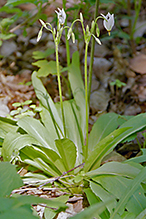 |
|||||
Inflorescence |
|||||
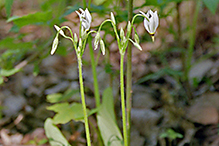 |
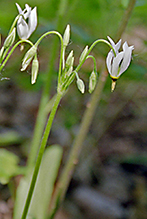 |
||||
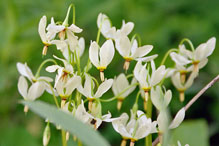 |
|||||

Slideshows |
||
| Dodecatheon meadia Susanne Wiik |
||

|
||
About
Flekkgudeblom, Shooting star |
||
| Shooting Star J.Steinbock |
||

|
||
| Dodecatheon meadia SHOOTING STAR Frank Mayfield |
||

|
||

Visitor Videos |
|||
Share your video of this plant. |
|||
| This button not working for you? Simply email us at info@MinnesotaSeasons.com. Attach a video, a YouTube link, or a cloud storage link. |
|||
Other Videos |
|||
| Jacob's Ladder (Polemonium reptans) and Midland Shooting Star (Dodecatheon meadia) PrairieMoonNursery |
|||
About
Uploaded on Jun 4, 2010 http://www.priairemoon.com - It's early May at Prairie Moon Nursery and Jacob's Ladder and Midland Shooting Star are in bloom! |
|||
| Shooting Stars in Bloom Ionxchange |
|||
About
Published on Jun 5, 2012 Earthyman views Midland Shooting Stars (Dodecatheon meadii) in bloom in Wisconsin. This prairie planting was planted by Ion Exchange, Inc several years ago. http://ionxchange.com/products/DODECATHEON-MEADII-%7C-Midland-Shooting-Star.html |
|||

Visitor Sightings |
|||||
Report a sighting of this plant. |
|||||
| This button not working for you? Simply email us at info@MinnesotaSeasons.com. Be sure to include a location. |
|||||
|
|||||
MinnesotaSeasons.com Sightings |
|||||
|
|||||

|
Created: Last Updated: © MinnesotaSeasons.com. All rights reserved. |
